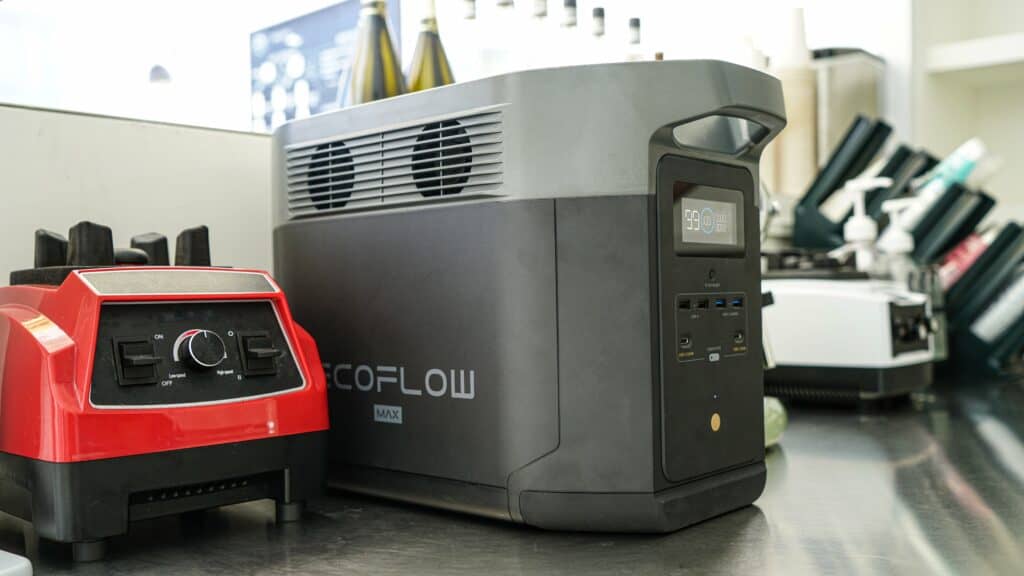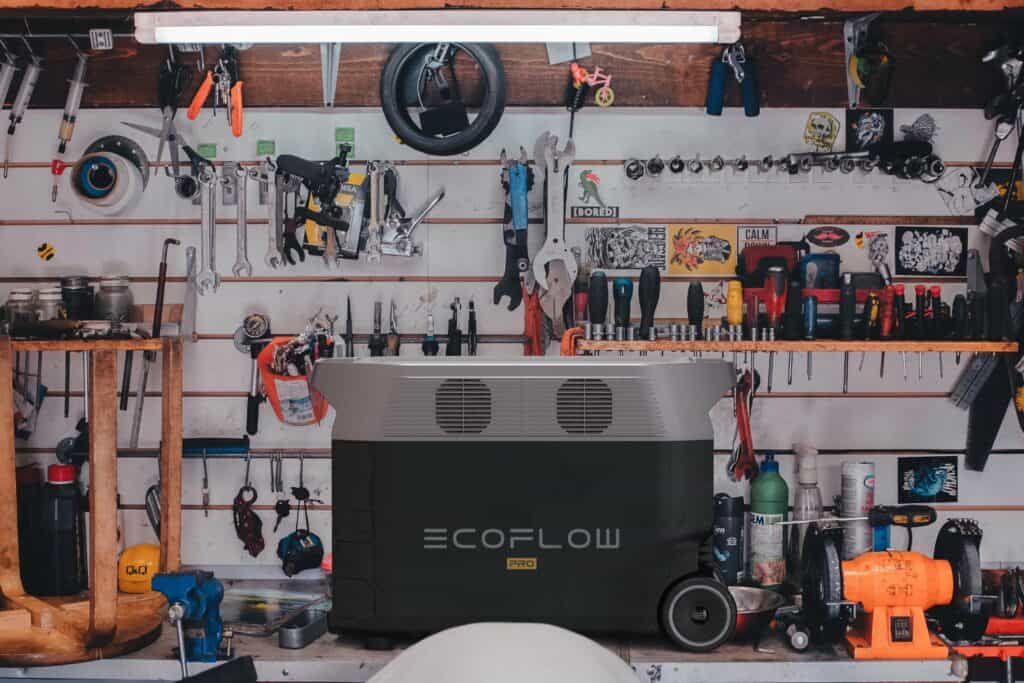Here’s our unboring, unalphabetical glossary of words you may have come across. It’s organized so that the information builds on itself as you read top to bottom (you can always Ctrl+F to find a particular term), and we assume you’re neither an idiot nor an engineer.

Battery Basics
Portable power station: An electronic device that powers electronics via a rechargeable battery. They generally have some combination of AC outlets, USB outlets, and sometimes less common types of outlets.
Generator: Something that creates electricity from solar energy, spinning magnets, turbines, etc. It seems common sense, but many players in this industry are referring to portable power stations – which only store energy – as “generators.”
Capacity: The size of the battery in terms of how much electricity it can provide. Capacity can be measured in watt-hours (Wh) or amp-hours (Ah). It’s measured in hours because turning on a light bulb for 1 hour versus 10 hours uses different amounts of electricity.
Amp (A): Think of it as the electricity equivalent of how much water is flowing out of a hose.
Volt (V): The electricity equivalent of the water pressure coming out of a hose. If the voltage from the power source is too high, it can damage your devices (like during a power surge) – too low, and it doesn’t provide enough oomph to get things going.
Watt (W): It’s amps times volts, so you can imagine it as the combination of the volume of water (amps) and the water pressure (volts). Going from a garden hose to a fire hose would mean more total power (watts) being sent out.
Charge cycle: A 100% full battery discharging until it’s completely dead (which should be avoided if possible) counts as one cycle. Likewise, only using it to 50% of its capacity counts as half of a cycle.
Cycle life: The lifespan of your battery as stated in the number of cycles. A rechargeable battery’s capacity decreases over time; a battery that could originally power a light for 100 hours will eventually only be able to power it for 80 hours, then 50 hours, etc… If the cycle life is stated as 500 cycles to 80% capacity, it means you can fully charge and discharge 500 times before your battery only powers that light for 80 hours (80% of 100 hours).
Shelf life: Batteries lose their charge even while being stored, and if they sit for a long time without being recharged, it can be damaging. Shelf life is the longest you should go between recharges.

Electrical Flows
Output: It’s the maximum amount of watts (electric power) that can be sent to something plugged in. If your portable power station has an output of 600W, you can power a 300W television but not an 800W toaster oven (or two 400W toaster ovens).
Surge: Some electronics need a lot of watts for brief moments, like when starting up. The surge rating, or “peak,” shows how high of a spike the portable power station can accommodate over short intervals.
Overload: Whenever the devices plugged in try to draw more watts than the source can supply.
Input: How much a portable power station takes in from a wall outlet, solar panel, or anything else recharging it. The higher the input wattage, the faster it recharges.
Charge time: How fast the battery recharges, which is dependent on input.
Fast charge: USB ports with this feature output more than the standard wattage, meaning compatible devices take in more energy and recharge faster.
X-Boost: EcoFlow’s proprietary technology lets higher-watt electronics be used by operating them at a reduced wattage. For example, the River 2 outputs a maximum of 300W which means you couldn’t power a 600W coffee maker. When its X-Boost is enabled (60W), it can handle a coffee maker so you can enjoy a hot cup while camping or in an RV.
X-Stream: Another of EcoFlow’s technologies that let its portable power stations input more power from a wall outlet for some of the fastest recharge times today. Not all EcoFlow PPS have this feature, including the River 2 series.
Alternating current (AC): The type of electricity your wall or gas generator supplies to your battery. It’s represented as ∿ on the back of some devices.
Direct current (DC): The type of electricity solar panels, cigarette lighter outlets, USB outlets, and batteries supply, and hence the type that most electronics consume. It’s represented as ⎓ on the back of some devices.
AC to DC conversion: The AC coming from the wall needs to be converted to DC for almost all electronics, which eats up some energy in the process. This all happens while your power station is charging.
DC to AC inversion: Pedants rejoice! You can say “inverter” instead of “converter” when talking about going from DC to AC. Since your battery is outputting DC, energy is lost when the electricity is inverted for the AC outlets. Tip: Using your portable power station’s DC outlets (USB outlets, car outlets, or DC 5521 ports) is much more efficient because there’s no inversion going on.
Pure sine wave: When inverting from DC to AC, the resulting electrical flow can be shaped like blocky waves (modified sine waves) instead of smooth rolling hills (pure sine waves), which damages devices. EcoFlow power stations produce pure sine waves because it benefits the compatibility and lifespan of connected electronics.
Solar
Monocrystalline: The premium solar panel with higher efficiency; blacker in colour.
Polycrystalline: The budget solar panel with lower efficiency; bluer in colour.
Chaining: Individual solar panels are connected together to increase the solar power generated.
Series connection: One solar panel’s positive (red, male) connector is connected to the adjacent panel’s negative (black, female) connector, and that panel’s positive connector is connected to the adjacent panel’s negative connector, and so on.
Parallel connection: Panels don’t connect to each other, they connect to a branched cable – one side is positive and one side is negative. Every panel’s positive end connects to one branch of the cable and likewise for the negative ends.

Wired and Wireless Connections
USB-A: The rectangular USB port that’s been around forever.
USB-C: A smaller, rounded USB port popular in smartphones and laptops.
XT60: A common plug that connects EcoFlow portable power stations to solar panels and cigarette outlets.
solar connector: A standard solar panel connector where the positive and negative ends are separated. Used to chain panels together and connect them to a battery. Hence, the EcoFlow Solar Charging Cable is solar connector on one end and XT60 on the other end.
Anderson port: A high voltage DC port commonly used to power the circuitry of camping trailers.
DC 5521: Also known as a barrel plug, this outlet is for recharging some smaller electronics like headlamps in order to avoid loss from DC to AC inversion.
Direct connection: Similar to Bluetooth, it’s used to wirelessly transfer information from a portable power station to a smartphone using Wi-Fi signals without the internet.
Infinity port: EcoFlow’s proprietary port for transferring both power and information to link DELTA Pro to a home, as well as EcoFlow’s Smart Generator, Smart Extra Battery, and another DELTA Pro.
Car outlet: For all intents and purposes, it’s the same as the cigarette lighter on your vehicle’s console (except that you can’t use those weird push button lighters on your portable power station). Don’t pass off this clunky outlet quite so fast; it uses DC, which means it’s more efficient than wall outlets because energy isn’t lost during inversion.
